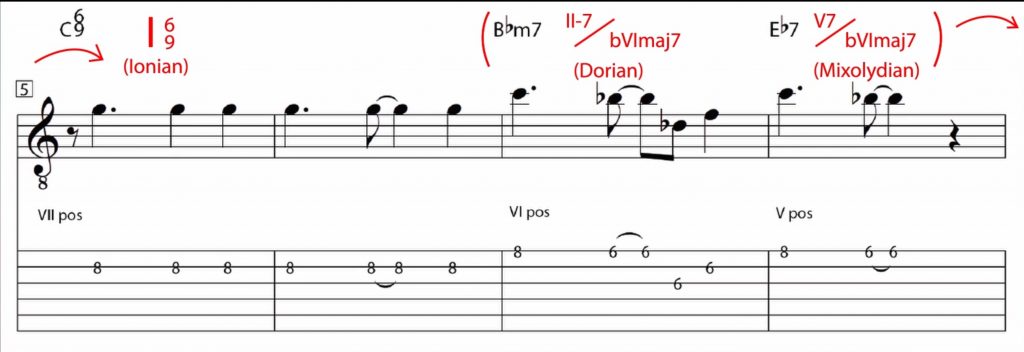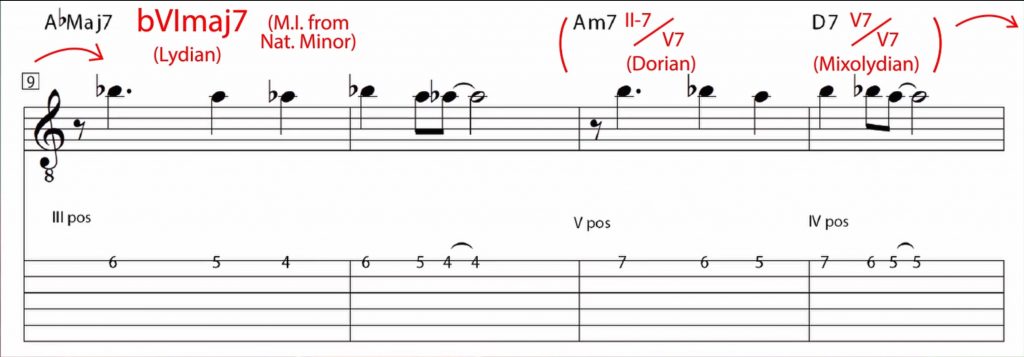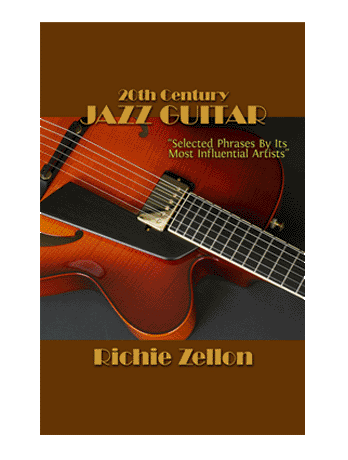“Lady Bird” Chord Melody
Transcribed from video:
Today I bring you the 2nd in a series of video tutorials entitled “Standards for Jazz Guitar” in which I first teach you the single note melody and then show you how I harmonize each note and come up with a chord melody arrangement. For this 2nd installment I’ve selected a bebop standard called “Lady Bird” by Tadd Dameron. If you watched my previous lesson in this series you’ll recall that it was a 12 measure piece. Well, this one is just a “tad” longer…pun intended. Maybe I should say a Tadd Dameron longer….ha,ha….. It’s 16 measures long. So stick with me because next you are going to hear me play and improvise over the main melody. Right after that I will analyze the tune for you and show you how to harmonize the melody as well as how I improvise over it.
( “Lady Bird” chord melody and solo in video)
“Lady Bird” Melody Chords & Harmonic Analysis
Let’s begin by analyzing the harmony to Lady Bird in 4 measure segments as I initially teach you the melody. This information will then serve to show you how to place a chord underneath each melody note.
First of all let me say that this tune is in the Key of C major. For those of you who have never been exposed to a harmonic analysis, what I’m going to do here is label each chord with roman numerals and explain its function within the tonality. And so you can better understand the short recurring progressions known as harmonic cadences, I will show you simultaneously how they progress through the cycle of descending 5ths in this chart. (shown in video). If you follow this series, as you watch me analyze various standards, you’ll soon come to see how these same cadences reappear and serve as the basis for all these tunes.
MEASURES: 1-4

We start out with a C6/9 for the for the 1st 2 measures. This is the I chord and traditionally uses a natural major scale or ionian mode.
The 3rd and 4th measures contain what is known as a double function cadence. So pay close attention to what I am going to point out, because this is intricate yet very interesting. At first glance you’ll notice that the Fm and the Bb7 form a II-V. In C the diatonic or primary II-V is comprised of Dm and G7. So it’s not that. Dominants within Secondary II-Vs resolve a perfect 5th down to chords other than the root. However, it’s not a Secondary II-V because it would have to resolve a perfect 5th down to Eb in the 5th measure. Instead we have a C there. So it is really functioning as a substitute II-V of the VI. Unlike a Secondary Dominant, a Substitute Dominant always resolves a 1/2 step down to its target. In this case Bb7 would need to resolve to Am. But instead it is followed by the I chord. How is this possible, you might ask? Well it’s known as a deceptive resolution. What is going on here, and the reason it works so well, is because C major is the major relative of A minor. So the original resolution has been substituted with its relative which has the same notes and function.
Now, I mentioned it’s a dual function cadence. The second function becomes evident by analyzing its chords as modal interchange which is when we borrow chords from the parallel minor tonality. In this case the Fm7 is the IVm of the natural minor or aeolian mode while the Bb7 is its bVII7. They would use the dorian and mixolydian respectively, although the Bb7 can also use the Lydian b7.
MEASURES: 5-8

Starting at measure 5 we have the I 6/9 for 2 measures. This is followed by Bbm7 and Eb7 on the 7th and 8th measures. This is clearly the secondary II-V of the bVImaj7 and we can see that it in fact resolves to the Abmaj7 in measure 9. Again we use the dorian and mixolydian for this II-V.
MEASURES: 9-12

On the 9th and 10th measures we have the bVImaj7 which is modal interchange from the parallel natural minor tonality. This would use an Ab lydian to improvise. The 11th and 12th measures are taken up by the secondary II-V of the V. D7 resolves to G7 which we see in the 14th measure.
The Dm7 in the 13th measure is simply an appended II- chord as are all II- chords which are added simply to create motion. Resolution takes place when a dominant resolves a perfect 5th down. This is what establishes a sense of tonality. II minor chords have a sub-dominant function and are more like helper chords as I said to add motion and added color to the progression. As a matter of fact, if I were to eliminate all the II-7 chords here and just play the dominants in their place, the tune would still work. Furthermore, if you ever want to simplify a tune, that’s one way of doing it, although you’ll in essence be “de-jazzifying” it….ha,ha..
MEASURES: 13-16

So the final 4 measures introduce the primary II-V of the key in measures 13 and 14 which are of course dorian and mixolydian based….and then we have a turnaround comprised of 3 modal interchange chords all of which employ the lydian mode. The Cmajor7 or I chord is followed by an Ebmaj7 which is the bIIImajor7, then Abmajor7 which is the bVImaj7, and finally the Dbmaj7 which is the bIImaj7. These 3 chords are all derived from the parallel natural minor. The Dbmajor 7 like I explained in the previous lesson with “Solar”, is acquired from the parallel minor tonality by simply lowering the root of the IIm7b5 a 1/2 step down.
PDF & AUDIO DOWNLOAD:
The Lady Bird download includes: a 2 PDFs (leadsheet and chord melody) with both regular notation and TAB, an MP3 of the arrangement and a backing track, as well as a Band in a Box File.
[Content protected for Elite, Elite 3 Month, Elite 6 Month members only]
1 Comment
Submit a Comment
You must be logged in to post a comment.

Your solos are seamlessly connected…….Just Beautiful!!